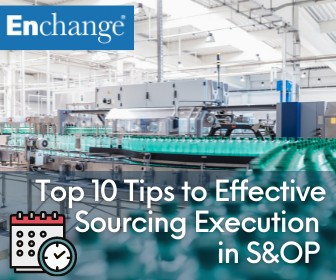The Enchange Supply Chain House; the one-stop shop for the elements you need to achieve supply chain excellence.
In successful FMCG companies, Sales & Operational Planning (S&OP) is the flexible glue that holds your processes together, ensuring demand and supply are balanced along the chain and most importantly, sees everyone operate to the same set of unambiguous sales, volume and financial numbers.
To date, we have provided Top 10 Tips for each of the key stages of S&OP.
- Demand Review - have you captured unconstrained demand?
- Supply Review - what is available and what is not?
- Financial Evaluation - how do these plans convert to cash?
- Consensus - is everybody on board with the plan?
This article looks at what your supply chain needs to execute your finished goods sourcing plans in support of the S&OP process and ultimately, business success.

Top 10 Tips – S&OP Sourcing Execution
1. Factory Scheduling & Supplier Planning Policies. Is a Factory Schedule or ‘Golden Rules’ Policy followed to monitor stability and responsiveness? Is accountability for maintaining factory scheduling and data integrity clear? Is there a Supplier Planning Policy detailing clarity on the respective responsibilities of the Supplier Scheduler and Buyer, including at what point each is responsible for problem resolution? Is there a Purchasing Policy stating the criteria that defines 'key' items, which are planned via a Supplier Scheduling Process?
2. Factory Scheduling & Supplier Planning Process & Procedures. Are these all clearly documented and focussed on maintaining inventories and service to agreed policy levels?
3. Communications. Is there an established communication processes among planning, production and buying for the purpose of maintaining a valid production schedule? Does this include a regular (usually weekly) scheduling communications meeting?
4. Time Horizons & Buckets. Is factory scheduling 'firmed up' over a sufficient horizon to enable stability of operations? Do the guidelines for this horizon include cumulative material lead time, lead time to planned production and lead time to cover customer order backlog? Is factory scheduling in daily or smaller buckets and replanned at least weekly? Are time periods on the supplier schedule in weeks or less for at least the coming 4 weeks?
5. Production Output. Is linearity of production output measured? Do the tabular and graphic illustrations of results reflect daily performance to a planned linear output? Are reasons for deviation highlighted with appropriate analysis?
6. Final assembly mechanism or Kanban approach. Is there a robust system in place to coordinate with the factory schedule to pursue customer orders to completion or replenishment of finished goods?
7. Supplier Schedule. Do suppliers proactively plan materials and capacity to meet the requirements of the schedule? Does the supplier schedule display planned orders and/or scheduled receipts over the period of the planning horizon for all items? Are commitment zones established in the supplier schedule and is that schedule updated with suppliers at least weekly?
8. Supplier Education & Performance. Have at least 80% of suppliers been educated in producer requirements and understand the supplier scheduling process? Has accountability for supplier delivery been established within a Service Level Agreement (SLA) including agreed performance metrics? Is supplier delivery performance >95% of the plan for at least key materials?
9. VMI Suppliers. Is RM & PM replenishment working well in maintaining stocks and service at policy/SLA levels?
10. Call-Off Suppliers. Is the producer call-off process clearly defined and maintains RM & PM stocks at policy levels?
The Plan, Make and Deliver disciplines of SCOR are rendered irrelevant with an inadequate focus on suppliers. Relationships can be difficult to forge but closer integration of suppliers with the producer S&OP will pay dividends. These Top 10 Tips provide an excellent foundation for a mutually beneficial business relationship.
Read more articles on Supply Chain Excellence and Route To Market on our website where you can also subscribe to our frequent updates.
Finally, feel free to use any of our contact routes including Live Chat, if you have any questions about how the Enchange Supply Chain House can assist your journey to supply chain excellence.







